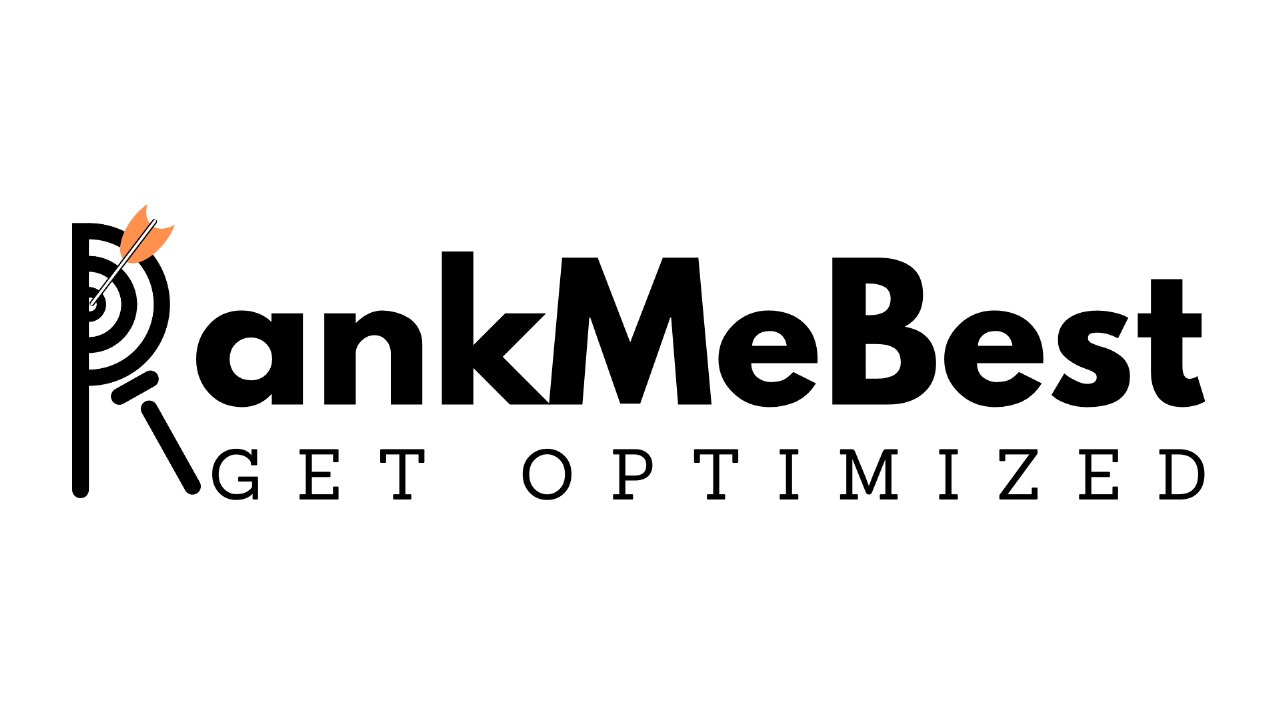
13 Most Effective Types of Marketing in India (2025 Guide)
In 2025, marketing in India is evolving faster than ever. With over 850 million internet users, widespread smartphone adoption, and booming digital commerce, startups, small businesses, and marketing professionals need to rethink how they connect with Indian audiences. Whether you’re in Mumbai’s bustling startup ecosystem or a local business in Kochi, knowing the right marketing type can make or break your growth.
This blog is your go-to guide to understanding the 13 most effective types of marketing in 2025, tailored specifically for Indian users. We’re not just listing jargon — we’re diving deep into what works, why it works in India, and how you can implement it with real brand examples like Nykaa, Zomato, Patanjali, boAt, and more.
Whether you’re planning your first influencer campaign, exploring SEO or WhatsApp marketing, or trying to maximize ROI on a shoestring budget, this guide is designed to help you choose the right strategies that match your business goals, audience behavior, and regional trends.
Let’s decode the future of marketing — made for India, built for results.
Type #1: Content Marketing
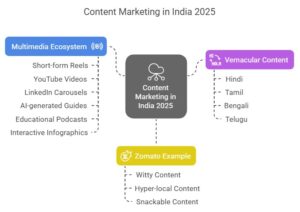
What it is:
Content marketing is all about creating and distributing valuable, relevant, and consistent content to attract and retain a clearly defined audience—and ultimately, drive profitable customer action.
In 2025, content marketing in India is no longer just about writing blogs. It’s a multimedia ecosystem—from short-form Reels, regional language YouTube videos, LinkedIn carousels, to AI-generated guides, educational podcasts, and interactive infographics.
Why it works in India:
India’s internet consumption is content-first, with users seeking answers, entertainment, and education online. With the rise of vernacular content, even Tier 2 and Tier 3 cities are engaging through regional content in Hindi, Tamil, Bengali, Telugu, and more.
Real Indian Example:
👉 Zomato built a massive following by using witty, hyper-local, and snackable content tailored for Indian audiences. Their push notifications, memes, and blogs go viral because they speak the language of the people—literally and culturally.
Top Content Formats for 2025 India:
-
Blog posts and how-to guides
-
YouTube tutorials in regional languages
-
Instagram Reels and carousels
-
LinkedIn thought leadership content
-
AI-generated blog content (with human editing)
-
WhatsApp mini-newsletters
Pro Tip:
Use AI tools like ChatGPT + Canva to generate content fast, but always edit for tone, clarity, and originality. In 2025, authenticity > automation.
Best for:
Startups, solopreneurs, coaches, SaaS tools, ecommerce brands, and educational platforms.
🌟 Type #2: Influencer Marketing
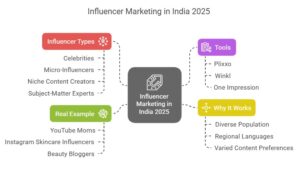
What it is:
Influencer marketing involves collaborating with individuals who have a loyal online following to promote your brand, product, or service. These influencers could be celebrities, micro-influencers, niche content creators, or even subject-matter experts.
In 2025, influencer marketing in India has matured into a structured and ROI-driven strategy. Thanks to tools like Plixxo, Winkl, and One Impression, Indian brands can now find, track, and collaborate with influencers across categories and languages.
Why it works in India:
India’s diverse population, regional languages, and varied content preferences make influencer marketing hyper-targeted and scalable. From a fashion creator in Delhi to a tech vlogger in Kerala, there’s an influencer for every niche and region.
Real Indian Example:
👉 Mamaearth scaled its D2C beauty brand by strategically collaborating with YouTube moms, Instagram skincare influencers, and beauty bloggers, tailoring content for both metros and Tier 2 audiences. Their influencer-led approach drove brand trust and conversion.
Popular Indian Influencer Platforms (2025):
-
Instagram Reels & Stories
-
YouTube Shorts & Product Reviews
-
Moj & Josh (for regional audiences)
-
LinkedIn for B2B product promotions
-
Twitter/X for thought leadership
Micro vs. Macro Influencers:
-
Micro: (10K–100K followers) – Higher engagement, niche audience
-
Macro: (100K–1M+ followers) – Massive reach, brand visibility
Pro Tip:
Use UTM links and influencer-specific coupon codes to track ROI accurately. Always look for engagement rates, not just followers.
Best for:
Fashion, beauty, tech, food, fitness, parenting, and regional brands.
📱 Type #3: Social Media Marketing
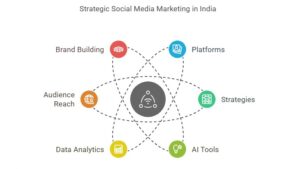
What it is:
Social Media Marketing (SMM) is the strategic use of platforms like Instagram, Facebook, LinkedIn, X (formerly Twitter), Pinterest, and YouTube to build brand awareness, engage users, drive website traffic, and increase sales.
In 2025, Indian startups and small businesses are no longer just “posting for visibility.” They’re running platform-specific campaigns, using AI-driven scheduling tools, and leveraging data analytics to grow strategically.
Why it works in India:
With over 850+ million internet users, India has one of the largest social media audiences in the world. Whether you’re targeting college students in Bangalore or homemakers in Indore, social media allows you to reach and segment your audience with precision.
Real Indian Example:
👉 boAt Lifestyle, a leading audio brand, built its cult following via Instagram memes, product teasers, influencer shoutouts, and strategic YouTube sponsorships. Their millennial-first content helped them become a top D2C brand in India.
Best Platforms for Indian Businesses in 2025:
-
Instagram: For lifestyle, fashion, food, wellness, and youth-centric brands
-
Facebook: For community building, service promotions, and local ads
-
LinkedIn: Ideal for B2B, SaaS, and startup thought leadership
-
YouTube: Long-form reviews, tutorials, regional content
-
X (Twitter): Real-time updates, customer service, and news
-
Pinterest: For decor, fashion, DIY, and inspiration boards
Pro Tip:
Use platform-specific content formats – like Instagram Reels, LinkedIn documents, or YouTube Shorts – to boost algorithm reach and engagement.
Best for:
Startups, e-commerce brands, coaches, agencies, B2B companies, personal brands.
📧 Type #4: Email Marketing
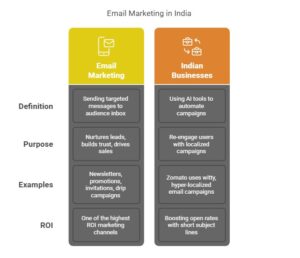
What it is:
Email marketing is the practice of sending personalized, targeted messages directly to your audience’s inbox. It includes newsletters, product promotions, event invitations, drip campaigns, and customer nurturing sequences.
In 2025, Indian startups and businesses are embracing AI-powered email tools like Mailmodo, Zoho Campaigns, and Mailchimp to automate and personalize campaigns at scale — ensuring better open rates, click-through rates (CTR), and conversions.
Why it works in India:
Email marketing remains one of the highest ROI marketing channels globally, and India is catching up fast. Especially for B2B startups, D2C brands, coaches, and e-commerce stores, email nurtures leads, builds trust, and drives sales better than almost any other channel.
Real Indian Example:
👉 Zomato uses clever, witty, and hyper-localized email campaigns to re-engage users — like “Hungry, Delhi?” or festive discounts tied to Holi or Diwali. Their subject lines are short, funny, and city-specific, boosting open rates massively.
Best Email Strategies for Indian Businesses in 2025:
-
Personalized subject lines using customer data (city, interest, past orders)
-
Interactive AMP emails (using platforms like Mailmodo)
-
Automated abandoned cart emails for e-commerce
-
Festival-specific campaigns (Diwali sales, Independence Day offers)
-
Newsletter content: Industry insights, product updates, exclusive deals
Pro Tip:
Avoid spamming! Focus on value-driven content with a clear CTA (call to action) in every email.
Best for:
E-commerce brands, SaaS startups, educational platforms, digital coaches, B2B companies.
🔍 Type #5: Search Engine Optimization (SEO)
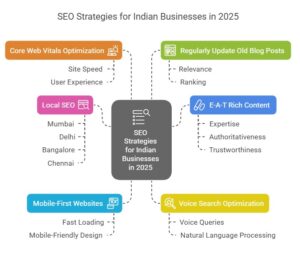
What it is:
SEO (Search Engine Optimization) is the art and science of optimizing your website, blogs, and online content to rank higher on search engines like Google. It involves keyword research, on-page optimization, technical improvements, backlink building, and content marketing — all aimed at driving organic traffic.
Why it works in India:
In 2025, with over 900 million active internet users in India, organic Google search remains one of the most trusted ways users discover products, services, and brands. Ranking higher means greater visibility, credibility, and more leads without paying for ads.
Real Indian Example:
👉 UrbanClap (now Urban Company) scaled rapidly by optimizing for local SEO keywords like “salon services near me” and “home cleaning Delhi.” Their focus on mobile optimization and customer reviews helped them dominate Google’s top results for service-based searches.
Best SEO Strategies for Indian Businesses in 2025:
-
Focus on local SEO (optimize for cities like Mumbai, Delhi, Bangalore, Chennai)
-
Mobile-first websites: India is mobile-dominant — your site MUST load fast on phones
-
Voice search optimization: Indians often use voice queries — “best biryani near me”
-
Create E-A-T rich content: Show Expertise, Authoritativeness, Trustworthiness
-
Core Web Vitals optimization: Make your site lightning-fast and user-friendly
-
Regularly update old blog posts to stay relevant and rank higher
Pro Tip:
Use long-tail keywords that reflect how Indians search — e.g., instead of just “digital marketing,” target “affordable digital marketing agency in Pune.”
Best for:
Almost every business — startups, SaaS platforms, e-commerce brands, bloggers, and consultants.
🎥 Type #6: Video Marketing
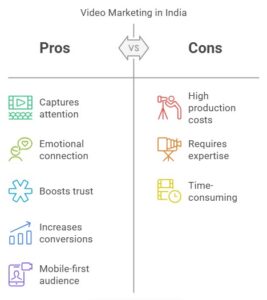
What it is:
Video marketing involves creating and sharing videos to promote products, services, or brand messages. This includes YouTube videos, Instagram Reels, LinkedIn videos, product demos, customer testimonials, webinars, and even explainer videos.
Why it works in India:
By 2025, India will have the world’s largest audience of online video viewers, driven by cheap internet (thank you, Jio!) and mobile-first consumption habits. Whether it’s a 90-second Instagram Reel or a detailed 10-minute YouTube review, videos capture attention faster and more emotionally than text or images.
Real Indian Example:
👉 Lenskart heavily uses video ads, product explainers, and customer testimonial videos across Facebook, Instagram, and YouTube to boost trust and sales. Their AR-based “virtual try-on” videos also went viral, increasing online conversions significantly.
Best Video Marketing Strategies for Indian Businesses in 2025:
-
Short-form videos (Reels, YouTube Shorts) are crucial for grabbing attention fast
-
Regional language content: Make videos in Hindi, Tamil, Bengali, Marathi, etc. to connect deeply
-
Educational videos: Tutorials, “how-to” guides, and webinars position you as an expert
-
Product demos and testimonials build trust for ecommerce and service businesses
-
Live streaming: Go live on Instagram, Facebook, or YouTube to engage your audience in real-time
Pro Tip:
Even if you’re a small business, you don’t need expensive equipment. Your smartphone + Canva + InShot app is enough to create high-quality videos today!
Best for:
Ecommerce brands, coaches, trainers, service providers, tech startups, food and beverage brands, real estate companies.
💰 Type #7: Paid Advertising (PPC)
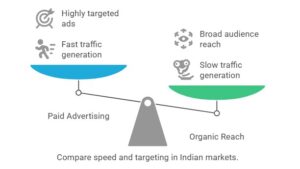
What it is:
Paid Advertising (also called Pay-Per-Click or PPC) means you pay platforms like Google, Facebook, Instagram, or LinkedIn to show your ad to a targeted audience. You’re charged only when someone clicks on your ad.
It’s a fast, highly targeted way to drive traffic, leads, or sales — perfect for competitive Indian markets where organic reach can be slow.
Why it works in India:
Indian users are searching, scrolling, and shopping online more than ever in 2025. With affordable smartphones and increasing internet penetration (especially in Tier-2, Tier-3 cities), ads on Google, Instagram, and YouTube help businesses reach the right buyers instantly.
Real Indian Example:
👉 UrbanClap (now Urban Company) used Google Search Ads and Facebook retargeting ads to scale their business in Tier-1 cities. Their location-based PPC strategy ensured that when someone in Mumbai searched for “home cleaning services,” Urban Company ads were right there — leading to massive lead generation.
Best Paid Advertising Strategies for Indian Businesses in 2025:
-
Google Ads: Target “near me” searches for local services like “best salon near me,” “plumber in Bangalore,” etc.
-
Meta Ads (Facebook + Instagram): Run carousel ads, video ads, and lead generation forms.
-
LinkedIn Ads: For B2B marketing targeting Indian SMEs, corporates, or startups.
-
YouTube Ads: For brand awareness using skippable or bumper ads.
-
Retargeting campaigns: Show ads to people who visited your website but didn’t convert.
-
Festive Season PPC: Run special Diwali, Holi, Eid offers to tap into high-spending times.
Pro Tip:
Set daily budgets carefully to avoid overspending. And always A/B test multiple ad creatives for the best results!
Best for:
Startups, ecommerce businesses, coaching institutes, SaaS companies, real estate businesses, healthcare clinics.
🤝 Type #8: Affiliate Marketing
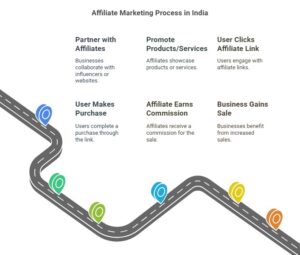
What it is:
Affiliate Marketing means partnering with individuals, influencers, or websites who promote your products or services. In return, they earn a commission for each sale, lead, or customer they bring in.
It’s like outsourcing your sales team, but you pay only when results are achieved — making it a low-risk, high-reward strategy.
Why it works in India:
Affiliate marketing has boomed in India post-2020, especially with the rise of bloggers, YouTubers, Instagram influencers, and micro-creators.
In 2025, Indian consumers trust recommendations from content creators more than direct brand ads. That trust can translate into better conversions and higher ROI.
Real Indian Example:
👉 Amazon India has one of the largest affiliate programs. Content creators across India review products like mobile phones, beauty products, and kitchen appliances — sharing affiliate links.
Every time a user clicks and purchases, the creator earns a commission, and Amazon gains a sale without running traditional ads.
Similarly, EdTech brands like Byju’s and Unacademy collaborate with educational bloggers and YouTubers to promote their courses via affiliate marketing.
Best Affiliate Marketing Strategies for Indian Businesses in 2025:
-
Partner with Indian niche bloggers, YouTubers, or Instagram creators who align with your industry (tech, fashion, food, finance, education, etc.).
-
Offer attractive commission rates and bonuses for high performers.
-
Use custom affiliate dashboards (like Impact, FirstPromoter, or in-house tools) to track performance.
-
Promote affiliate partnerships during festive sales seasons like Diwali, Rakhi, and New Year.
-
Focus on long-term collaborations rather than one-off promotions.
Pro Tip:
Build a small, high-quality network of affiliates who actually understand your product — quality always beats quantity.
Best for:
E-commerce brands, SaaS startups, EdTech companies, personal care brands, finance apps.
💥 Type #9: Influencer-Led Commerce (New Trend in India 2025)
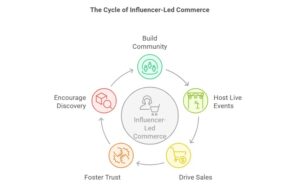
What it is:
Influencer-Led Commerce means directly selling products through influencers who have built strong, niche communities.
Instead of just promoting your brand, influencers act as storefronts, hosting live product demos, reviews, and exclusive sales for their audiences.
It’s shopping meets storytelling — creating a personal, trust-driven buying experience.
Why it’s booming in India:
-
By 2025, over 60% of Indian Gen Z and Millennials prefer discovering products via influencers rather than traditional ads.
-
Platforms like Instagram Shopping, YouTube Live Shopping, and emerging Indian apps like Trell, Roposo, and Meesho are encouraging creators to sell products directly.
-
Live commerce (especially during sales events like Diwali and Independence Day) is taking off.
Real Indian Example:
👉 Nykaa collaborates with beauty influencers for live tutorials and shopping events. Followers can instantly buy featured products while watching the video.
👉 CRED partners with finance influencers to host webinars and app walkthroughs that nudge users toward specific product signups.
This is not just promotion — it’s instant commerce.
Best Influencer-Led Commerce Strategies for Indian Businesses in 2025:
-
Host Instagram Live Shopping or YouTube Live sessions featuring your products.
-
Collaborate with regional influencers speaking Hindi, Tamil, Bengali, or Marathi for wider Indian reach.
-
Offer limited-time influencer-exclusive discounts to drive urgency.
-
Use creator marketplaces like Winkl, OPA, or Plixxo to find the right influencers.
-
Focus on micro and nano-influencers (5,000–50,000 followers) for deeper niche engagement.
Pro Tip:
Always co-create authentic content with influencers instead of giving them scripted ads — trust and relatability drive higher conversions.
Best for:
Fashion brands, beauty products, D2C startups, mobile accessories, fitness gear.
🎪 Type #10: Event Marketing (Physical + Virtual)
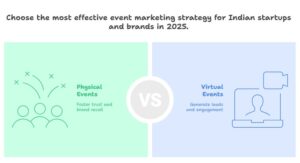
What it is:
Event marketing means promoting your brand through live events — whether in-person, virtual, or hybrid.
It could be a product launch, a workshop, an industry conference, a webinar, or even a festive pop-up shop.
It creates personal touchpoints that build trust, boost brand recall, and spark real engagement.
Why it’s crucial in India (2025):
-
Indian consumers still love face-to-face experiences, especially for high-investment or lifestyle products.
-
Virtual events and webinars have exploded post-2020, and in 2025, hybrid (physical + online) formats are the norm.
-
Festivals like Diwali, Holi, and Independence Day offer massive event marketing opportunities.
Real Indian Example:
👉 Zomato regularly hosts food festivals like Zomaland, mixing music, food stalls, and brand promotions — strengthening loyalty and social buzz.
👉 Byju’s and Vedantu organize free educational webinars and demo classes online, gaining thousands of new leads.
Best Event Marketing Strategies for Indian Startups and Brands in 2025:
-
Host festive-themed pop-ups in malls during Diwali or Raksha Bandhan.
-
Conduct free workshops related to your niche (e.g., fitness sessions for health brands, makeup masterclasses for beauty startups).
-
Create virtual launch events using platforms like Airmeet, Zoom, or Hopin.
-
Offer early-bird registrations, giveaways, and influencer collaborations to boost participation.
-
Record your events and repurpose them into Instagram Reels, YouTube videos, or blog posts.
Pro Tip:
For physical events, hyperlocal SEO and Google My Business promotions are a must. For virtual ones, email campaigns and WhatsApp groups work wonders in India.
Best for:
Tech startups, education platforms, D2C brands, lifestyle and fashion businesses, service industries.
🗣️ Type #11: Referral Marketing (Word of Mouth 2.0)
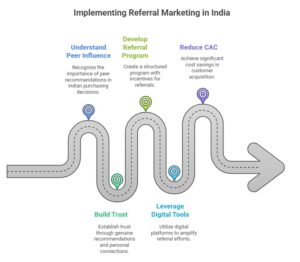
What it is:
Referral marketing is when your existing customers recommend your brand to their friends, family, or networks — often in exchange for rewards, discounts, or incentives.
It’s modern word-of-mouth marketing, supercharged by digital tools like WhatsApp, social media, and referral apps.
Why it’s crucial in India (2025):
-
Indians heavily rely on peer recommendations before purchasing — especially for financial services, edtech, D2C brands, and local businesses.
-
Trust is everything. A friend’s advice > An ad for many Indians.
-
Referral programs can lower your customer acquisition cost (CAC) dramatically.
Real Indian Example:
👉 Cred offers its users Cred Coins and cashback for referring friends to their credit card bill payment app.
👉 Groww (investment app) uses a “Refer and Earn” strategy — you invite friends, and both parties get ₹100 free in their wallets.
Best Referral Marketing Strategies for Indian Startups and Brands in 2025:
-
Create a simple, mobile-first referral program (most Indians prefer sharing via WhatsApp and Instagram DM).
-
Offer mutual benefits: reward both the referrer and the referee.
-
Make sharing super easy — clickable WhatsApp links, QR codes, or SMS invites.
-
Tie referrals to special occasions (e.g., “Refer 3 friends and win Diwali gift vouchers”).
-
Highlight customer testimonials and success stories on your website and social channels.
Pro Tip:
Gamify it!
Leaderboard contests (“Top 10 referrers this month win an iPhone!”) work incredibly well in India.
Best for:
Fintech apps, edtech startups, SaaS platforms, ecommerce websites, fitness and health services.
🎨 Type #12: Guerrilla Marketing (Creative Low-Cost Campaigns)
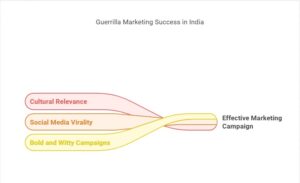
What it is:
Guerrilla marketing is all about using unconventional, surprising, and low-cost tactics to grab massive attention in public spaces or online.
It’s not about spending big, it’s about thinking creatively to spark conversations, selfies, shares, and even media coverage.
Why it’s powerful in India (2025):
-
Indian audiences love bold, witty, and culturally relevant campaigns.
-
With social media virality and short attention spans, a clever campaign can reach millions overnight — even with a small budget.
-
Local relevance matters a lot — memes, festivals, and trending topics are huge opportunities.
Real Indian Example:
👉 Zomato’s witty billboards like “Order Karke Dekho” cleverly play on Bollywood lines and trends, catching everyone’s eye on the road.
👉 Fevicol’s iconic ads — whether a billboard during elections (“Fevicol Jod” for political unity) or a viral Holi post — master guerrilla creativity rooted in Indian culture.
Best Guerrilla Marketing Ideas for Indian Brands in 2025:
-
Flash mobs in malls or metro stations (with viral dance or campaign themes).
-
Funny sticker campaigns on autos, bikes, or near colleges.
-
Interactive murals where passersby can click selfies (perfect for Instagram).
-
Topical billboards that comment on cricket matches, elections, movie releases.
-
“Pop-up” experiential booths at tech fests, Diwali melas, shopping fairs.
Pro Tip:
Always tie the guerrilla idea to a hashtag for Instagram and Reels discovery.
Best for:
Food brands, D2C brands, startups in youth markets, OTT platforms, edtech, and any brand with a bold voice.
📻 Type #13: Traditional Marketing (Still Alive and Kicking!)
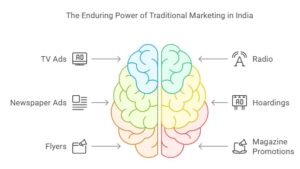
What it is:
Traditional marketing covers offline advertising methods like TV ads, radio, newspaper ads, hoardings, flyers, and magazine promotions.
Even though digital is booming in 2025, traditional marketing still plays a big role — especially in tier 2, 3, and rural markets of India.
Why it’s powerful in India (2025):
-
A huge chunk of the Indian population still consumes TV, radio, and print media daily, especially in regional languages.
-
Trust levels for traditional ads are still higher in many sectors like real estate, education, healthcare, jewelry, and FMCG.
-
Big events like IPL, elections, and festivals heavily rely on traditional mediums for mass outreach.
Real Indian Example:
👉 Amul’s newspaper ads continue to create daily topical cartoons in print — a classic brand building masterclass.
👉 LIC’s billboard ads and campaigns during cricket matches and city marathons still capture huge public attention.
👉 Tanishq runs integrated TV + newspaper + digital campaigns during Diwali and weddings — tapping into all audience layers.
Best Traditional Marketing Ideas for Indian Brands in 2025:
-
TV ads during IPL, World Cup, Bigg Boss, or popular soap operas.
-
FM radio jingles with catchy regional language slogans.
-
Full-page newspaper ads around festival sales, product launches, or political messaging.
-
Bus shelter ads, metro ads, train wraps for urban impact.
-
Pamphlet drops in hyperlocal regions for education, healthcare, and home services.
Pro Tip:
Combine traditional with digital. (Example: Newspaper ad + QR code for app download = hybrid marketing!)
Best for:
Jewelry brands, real estate, political campaigns, edtech, FMCG, automotive, healthcare, and wedding-related businesses.
🧩 How to Choose the Right Marketing Type for Your Business in India (2025 Guide)
Choosing the right marketing strategy can make or break your business growth in 2025 — especially in India’s dynamic digital + traditional market.
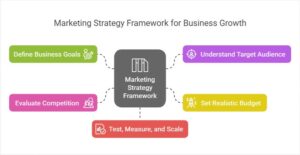
Here’s a simple framework you can follow:
1. 🎯 Define Your Business Goals
-
Brand Awareness? → Focus on Social Media Marketing, Influencer Marketing, Event Marketing.
-
Lead Generation? → SEO, Paid Ads (Google/Facebook), Email Marketing.
-
Sales Conversion? → Affiliate Marketing, Referral Marketing, Influencer-Led Commerce.
Tip:
Write down clear KPIs like 10K Instagram followers, 100 website leads/month, or ₹5L in monthly ecommerce sales.
2. 🧑💻 Understand Your Target Audience
-
Urban Youth? → Instagram, YouTube, Reels, Influencers.
-
Working Professionals? → LinkedIn, Email Marketing, Content Marketing.
-
Tier 2/3 Rural Users? → TV Ads, Radio, WhatsApp Marketing, Local SEO.
Example:
If you’re selling organic skincare products, Instagram + Influencers + YouTube tutorials would be smarter than newspaper ads.
3. 💸 Set a Realistic Budget
-
Low budget? → Focus on SEO, Social Media, Guerrilla Marketing, Referral Campaigns.
-
Medium budget? → Add Email Marketing, Influencer Collaborations, Paid Ads.
-
High budget? → Run integrated campaigns across TV + Digital + Events.
Tip:
Always keep 15-20% reserve for sudden boosts — festive campaigns, IPL ads, etc.
4. 🏆 Evaluate the Competition
-
What are top competitors doing?
-
Are they ranking on Google? Running YouTube ads? Partnering with influencers?
Use tools like:
SEMrush, Ahrefs, Ubersuggest, and basic Instagram/LinkedIn search.
Example:
If your competitors are dominating SEO but weak on YouTube, maybe Video Marketing is your shortcut to leadership.
5. 🔥 Test, Measure, and Scale
-
Start small — pick 2–3 marketing types.
-
Measure results for 3 months (traffic, leads, sales).
-
Double down on what’s working. Cut or optimize what’s not.
Key Metrics to Track:
-
Website Traffic
-
Cost per Lead (CPL)
-
Customer Lifetime Value (CLV)
-
Social Media Engagement Rates
-
SEO Keyword Rankings
Final Thought:
🚀 In 2025 India, hybrid strategies win.
Combine 2–4 marketing types for full-funnel impact — from awareness to engagement to sales.
🎯 Conclusion
In 2025, marketing in India is more dynamic, diverse, and opportunity-rich than ever before.
From content marketing and SEO to the rise of influencer-led commerce and guerrilla campaigns, businesses now have more tools — but also more competition.
✅ Startups and small businesses must focus on cost-effective strategies like social media marketing, SEO, and referral marketing.
✅ Established brands should create integrated campaigns across digital, influencer, and traditional marketing to dominate the market.
✅ Marketing professionals and agencies must stay updated with consumer behavior trends, platform algorithm changes, and emerging marketing tools like AI-based personalization.
Real Success Formula for 2025:
“Customer-Centric Strategy + Consistent Execution + Creative Experimentation = Sustainable Growth.”
Remember:
There’s no one-size-fits-all.
The most successful Indian brands in 2025 will be those who adapt quickly, choose the right marketing mix, and always put the customer first.
✨ Whether you’re a startup in Bangalore, a boutique business in Jaipur, or a marketing agency in Mumbai — 2025 belongs to those who market smart, not just hard!
Now, it’s your turn:
Which marketing type will YOU focus on first this year? 🚀
